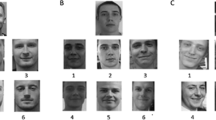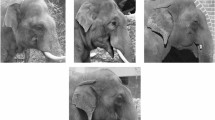Abstract
This paper presents Visual ENhancement of USers (VENUS), a system able to automatically enhance male and female frontal facial images exploiting a database of celebrities as reference patterns for attractiveness. Each face is represented by a set of landmark points that can be manually selected or automatically localized using active shape models. The faces can be compared remapping the landmarks by means of Catmull–Rom splines, a class of interpolating splines particularly useful to extract shape-based representations. Given the input image, its landmarks are compared against the known beauty templates and moved towards the K-nearest ones by 2D image warping. The VENUS performances have been evaluated by 20 volunteers on a set of images collected during the Festival of Creativity, held in Florence, Italy, on October 2007. The experiments show that the 73.9% of the beautified faces are more attractive than the original pictures.









Similar content being viewed by others
References
Alley TR, Cunningham MR (1991) Averaged faces are attractive, but very attractive faces are not average. Psychol Sci 2(2):123–125
Arakawa K, Nomoto K (2005) A system for beautifying face images using interactive evolutionary computing. In: Proceedings of the international symposium on intelligent signal processing and communication systems, pp 9–12
Avrithis Y, Xirouhakis Y, Kollias S (2001) Affine-invariant curve normalization for object shape representation, classification, and retrieval. Mach Vis Appl 13(2):80–94
Bookstein FL (1989) Principal warps: thin-plate splines and the decomposition of deformations. IEEE TPAMI 11(6):567–585
Catmull E, Rom R (1974) A class of local interpolating splines. Computer Aided Geometric Design, pp 317–326
Cootes TF, Taylor CJ, Cooper DH, Graham J (1995) Active shape models—their training and application. Comput Vis Image Underst 61(1):38–59
Davies RH (2002) Learning shape: optimal models for analysing natural variability. PhD thesis, Department of Imaging Science, University of Manchester
Eisenthal Y, Dror G, Ruppin E (2006) Facial attractiveness: beauty and the machine. Neural Comput 18(1):119–142
Farkas LG (1987) Linear proportions in above-and below-average women’s faces. Anthropometric facial proportions in medicine, 3rd edn. Charles C. Thomas, Springfield, pp 119–129
Fink B, Grammer K, Thornhill R (2001) Human (Homo sapiens) facial attractiveness in relation to skin texture and color. J Comp Psychol 115(1):92–99
Gomes J, Costa B, Darsa L, Velho L (1998) Warping and morphing of graphics objects. Morgan Kaufmann, San Francisco
Goodal C (1991) Procrustes methods in the statistical analysis of shapes. J Roy Stat Soc 53(2):285–339
Gunes H, Piccardi M (2006) Assessing facial beauty through proportion analysis by image processing and supervised learning. Int J Hum Comput Stud 64(12):1184–1199
Jefferson Y (2004) Facial beauty—establishing a universal standard. Int J Orthod 15(1):9–22
Langlois JH, Roggman LA (1990) Attractive faces are only average. Psychol Sci 1(2):115–121
Leyvand T, Cohen-Or D, Dror G, Lischinski D (2006) Digital face beautification. In: SIGGRAPH ’06, ACM SIGGRAPH 2006 Sketches. ACM, New York, p 169
Liu H, Yan J, Li Z, Zhang H (2007) Portrait beautification: a fast and robust approach. Image Vis Comput 25:1404–1413
Liu Z, Zhang C, Zhang Z (2007) Learning-based perceptual image quality improvement for video conferencing. In: Proceedings of IEEE international conference on multimedia and expo, 2007, pp 1035–1038
Maggini M, Melacci S, Sarti L (2007) Representation of facial features by Catmull–Rom splines. In: Proceedings of international conference on computer analysis of images and patterns. Springer, Berlin, pp 408–413
Martinez AM, Benavente R (1998) The AR face database. CVC Technical Report 24
Messer K, Matas J, Kittler J, Luettin J, Maitre G (1999) XM2VTSDB: the extended M2VTS database. In: International conference on audio and video-based biometric Person authentication, pp 72–77
Michiels G, Sather AH (1994) Determinants of facial attractiveness in a sample of white women. Int J Adult Orthod Orthognath Surg 9(2):95–103
Su P, Drysdale RLS (1995) A comparison of sequential Delaunay triangulation algorithms. In: Proceedings of the 11th symposium on computational geometry, pp 61–70
Swaddle JP, Cuthill IC (1995) Asymmetry and human facial attractiveness: symmetry may not always be beautiful. Proc Biol Sci 261(1360):111–116
Wang H, Kearney J, Atkinson K (2002) Arc-length parameterized spline curves for real-time simulation. In: International conference on curves and surfaces, pp 387–396
Author information
Authors and Affiliations
Corresponding author
Rights and permissions
About this article
Cite this article
Melacci, S., Sarti, L., Maggini, M. et al. A template-based approach to automatic face enhancement. Pattern Anal Applic 13, 289–300 (2010). https://doi.org/10.1007/s10044-009-0155-0
Received:
Accepted:
Published:
Issue Date:
DOI: https://doi.org/10.1007/s10044-009-0155-0




